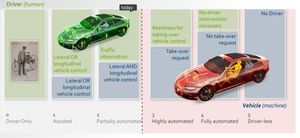KANBrief 2/20

The current development from partially to highly and fully automated driving, and ultimately to autonomous driving, is expected to deliver huge improvements in road safety. For this development to be successful, it must be supported by a regulatory framework within which solutions can be found that are safe for drivers and, if at all possible, harmonized throughout Europe or indeed worldwide.
The great majority of road accidents in Europe occur not for technical reasons but owing to human error, often as a result of distraction, misjudgement or overextension.
Vision Zero forms part of the agreement reached between the parties in Germany’s current coalition government, and has been set out in the road safety programmes of most of the individual states and large cities, such as Munich (Praesentation-Muenchen-Vision-Zero-Schreiner (pdf, in German)). In some countries (such as Sweden), it is even enshrined in law. The principle of Vision Zero is that human life is non-negotiable – even when people make mistakes. The German Road Safety Council (DVR) has demonstrated that its ten TOP measures are able to address the causes of around 90% of serious and fatal road accidents.
The current literature defines five levels in the process leading to autonomous driving. In level 2, semi-automated driving, support is provided in guiding the vehicle both longitudinally and laterally, and the traffic situation is detected for this purpose. Systems implementing this level, such as ACC (adaptive cruise control) and lane departure warning systems, have been on the market for several years and can now also be found in low-priced new cars. They are capable for example of preventing almost all rear-end collisions.
The next level (level 3) is highly automated driving, in which the drivers are required to act only when requested to resume control of the vehicle. Several vehicles equipped with level 3 technology for specific scenarios, such as motorway driving, have been announced for late 2020/early 2021. The BMW iNext is one example.
Level 4 is fully automated driving and level 5 driverless, “autonomous” driving. Owing to the high associated costs, it can however be assumed that levels 4 and 5 will rarely be available for private vehicles in the foreseeable future, and will be limited to special applications. Such applications could for example be trucks on long-haul routes in the USA, where the high cost of fully automated driving is recouped owing to the shortage of drivers and the savings in labour costs. Robot taxis and fully self-driving buses are also likely to emerge in local public transport.
In terms of road safety, it can be assumed that each successive level will significantly reduce the accident numbers. The decisive factor however is how this will be achieved: namely by driver assistance systems (DASs) growing in number and intelligence. The major gains for road safety will be delivered by the increasing use and resulting reduction in cost of these lower-level systems, rather than by the level 3 vehicles, which are expected to remain few in number even in the medium term.
At the end of 2019, the European Union adopted its far-reaching General Safety Regulation (GSR). This will progressively increase the number of important driver assistance systems that are mandatory: from 2022 onwards throughout the EU in new vehicle models, and from 2024 onwards in all new vehicle registrations. The regulation covers emergency braking systems, speed assistance systems, lane keeping systems, driver drowsiness and attention warning assistants, turning assistants, pedestrian detection systems, accident data recording systems, etc. Even though the effect of these systems over the coming years will be only gradual, the GSR will nevertheless make a tremendous contribution to road safety, parallel to that of automated driving.
The GSR describes the basic obligations of manufacturers and sets the target for safer vehicles. The actual minimum requirements for driver assistance systems are currently defined by United Nations Economic Commission for Europe (UNECE) provisions. These enable all vehicle manufacturers worldwide to develop systems of this kind and bring them to market in good time. From the perspective of road safety, this regulatory activity is particularly important for forward emergency braking and turning assistants, which detect pedestrians and cyclists in front of and alongside vehicles, warn the driver, and where necessary avoid collisions.
Professor Dr Walter Eichendorf
President of the German Road Safety Council (DVR)
Walter.Eichendorf@DVR.de